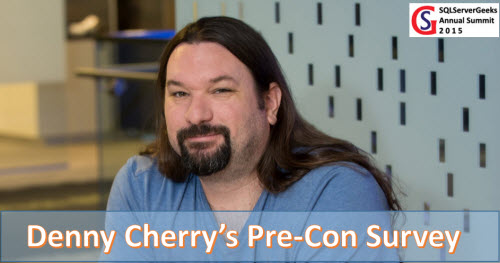Denny Cherry Pre-Con Survey
Excitement is building up – BIG TIME!
Yes, we announced Denny Cherry’s participation in Asia’s First SQL Conference and the response has been awesome.
Now, help shape up Denny Cherry’s pre-conference seminar. Apart from regular break-out sessions, Denny will be delivering a whole day pre-con seminar.

What is a pre-con seminar?
Pre-Conference Seminars are focused, day-long classes led by noted industry experts, and cover topics that address relevant issues for today’s SQL professionals. This education richly enhances your summit experience and expertise and prepares you for the session content and hands-on labs that are offered throughout the next 3 days! Pre-Con content is designed to provide you with a deep knowledge base and skills that you can apply to your immediate business needs.
SQLServerGeeks Annual Summit 2015 will have five pre-con seminars, each delivered by a MASTER! The 5 tracks are DBA, Developer, Analytics, Cloud & Big Data. Pre-Cons will happen on August 26. Regular Conference is from Aug 27 to 29.
Now, help us shape up Denny’s pre-con. Denny’s pre-con is meant for Database Administrators and will focus on the DBA track. He has proposed four options. The process is participating in this survey is very simple. Review the 4 choices below and then click here to submit your vote. That’s it! Isn’t this amazing that you are contributing and helping us shape up the conference. Yes, this is your conference. So go ahead and vote for your favorite topic in the DBA track pre-con!
If you have a facebook account, click here to cast your vote!
If you do not have a facebook account or do not want to use FB, click here to cast your vote!
[separator top=”20″ style=”shadow”]
Option 1: SQL Performance Tuning and Optimization
Abstract: In this session you will learn about SQL Server 2008 R2 and SQL Server 2012 performance tuning and optimization. Industry Expert Denny Cherry will guide you through tools and best practices for tuning queries and improving performance within Microsoft SQL Server. This session will guide you through real life performance problems which have been gathered and tuned using industry standard best practices and real world skills.
This session starts off with reviewing the various native tools which are available to you from Microsoft with your SQL Server License and how all of these tools can be used to help you performance tune your SQL Server installation. These tools include SQL Profiler, Extended Events, Database Tuning Advisor and more. We will use these tools to identify problem areas within the SQL Server database engine and how to solve for these problems.
We will look at the new ColumnStore index and how it can be used to improve performance within your data warehouse platforms, including how to use it in a data warehouse which needs to be written to through out the day bypassing the problem of the columnstore index being read only.
We will discuss some scaleout options which are available with Microsoft SQL Server both within the database by using table partitioning to spread the workload to multiple disks, as well as AlwaysOn Availability Groups and how they can be used to scale a database out across multiple servers.
Option 2: SQL Server 2014 in a Highly Available World
Abstract: In this day long pre-con session we will explore the various high availability options within SQL Server 2014 including how to configure these various options. We will be looking into Windows and SQL Server Clustering (including what is needed for a geographically dispersed cluster), Database Mirroring, The AlwaysOn feature of SQL Server 2014, and SQL Server Log Shipping.
In addition to working through these high availability options, we will be discussing the most important part of high availability configuration, making sure that you know how to select the correct high availability solution. After completing this high availability pre-con session you’ll be able to make the correct decision about which high availability decision to deploy, as well as how to correctly deploy the selected solution.
Learning all the available high availability options for your database.
Learning how to deploy these high availability solutions.
Learning how to explain high availability to your management so they understand why you made the decision that was made.
Option 3: SQL Server for the Non Database Administrator
In this all day session on Microsoft SQL Server we will be learning about how Microsoft SQL Server works and what needs to be done to keep it up and running smoothly when you don’t have a full time database administrator on staff to help you keep it running.
In this session we will cover a variety of topics including backups, upgrade paths, indexing, database maintenance, database corruption, patching, virtualization, disk configurations, high availability, database security, database mail, anti-viruses, scheduled jobs, and much, much more.
After taking this full day session on SQL Server you’ll be prepaired to take the information that we go over and get back to the office, get the SQL Server’s patched and properly configured so that they run without giving you problems for years to come.
Option 4: Storage and Virtualisation for DBAs
This session will be a two part session in which we will be focusing on two of the biggest topics in the DBA field. How to properly design your SAN storage solution and how to properly design your virtualization solution.
The storage portion of this session will focus on SAN storage, but most of the material will apply to direct attached storage as well.
In the first half of the session we’ll be focusing on the storage array. Storage can be one of the biggest bottlenecks when it comes to database performance. It’s also one of the hardest places to troubleshoot performance issues because storage engineers and database administrators often do not speak the same language. In this session, we’ll be looking at storage from both the database and storage perspectives. We’ll be digging into LUNs, HBAs, the fabric, as well as the storage configuration.
After going over the components we’ll dig into some advanced storage configurations. This includes RAID groups, multi-pathing software, and proper redundant storage network design. We will also be digging into some advanced storage array backup techniques including taking storage level clones and snapshots. After going over these advanced techniques we will dig into how these can best be used to backup the SQL Server environment to provide maximum redundancy with no recurring tape costs.
In addition to theory, we’ll be looking at an actual SAN so that we can translate what we see in the Storage Array with what we see on the actual server.
In the second half of the day we’ll be looking into the pros and cons of moving SQL Servers into a virtual server environment. Specifically we’ll be looking into when it’s a good idea and when it’s probably not a good idea. Like everything in the database world there are no hard set answers as to if virtualization is a good idea or not, but there are some times when virtualizing a SQL Server is a good idea, and can save you some money. There are some other times when you will be shooting yourself in the foot and virtualization isn’t a good idea. We’ll be focusing on when how to make this decision, and how to gather the metrics that you need in order to come to this decision.
We’ll look into how tie the virtual platforms to the storage array so that you can maximize the storage performance for your SQL Servers and the virtual environment.
Learn to talk to the storage admin
Learn best practices for server and storage configuration
Learn how to troubleshoot storage issues.
Why Thin provisioning can be bad for SQL Server
Network Design
Normal Storage Deckhem to maxamize performance.
[separator top=”20″ style=”shadow”]
Done reviewing the pre-con titles and abstracts? Now, use the below options to cast your vote.
If you have a facebook account, click here to cast your vote!
If you do not have a facebook account or do not want to use FB, click here to cast your vote!
Thank you for helping us shape the Asia’s First SQL Conference!




















